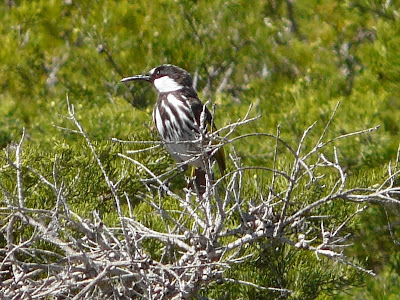This is not really another in the intermittent series on colours in nature; it's rather about some of the amazingly diverse (and creative) ways in which taxonomists have sought to say simply that an organism - or part of it - is black. One simple way is to use the Latin ater, implying 'dull' or 'gloomy' black.
 |
| Black Tiger Snake Notechis ater, Twin Creek Reserve, Western Australia. (This species is often now regarded as a subspecies of Tiger Snake N. scutatus.) |
 |
| Black Caiman Melanosuchus niger, Blanquillo Lodge, Peruvian Amazon. (The genus name means 'Black Crocodile', in case you missed the point; we'll get to melano- soon.) |
No-one said names have to make sense of course; Black Caimans aren't particularly glossy, and White-cheeked Honeyeaters are even less so; in fact much of them isn't black at all!
 |
| White-cheeked Honeyeater Philydonyris niger, Lesueur National Park, Western Australia. |
Variants of both these words can be used to describe 'degrees of blackness', or to specify black bits of the organism.
| Black Falcon Falco subniger, Bladensburg National Park, Queensland. In other words, 'a bit less than black'! |
 | |
| Pied Butcherbird Cracticus nigrogularis, Lake Logue Nature Reserve, Western Australia. The 'black throat' of the name is obvious here. |
 |
| Black-headed Skimmer Crocothemis nigrifrons, National Botanic Gardens Canberra. The species name just means 'black-fronted'. |
A derivative of ater is atratus, meaning 'clothed in black', or 'in mourning'.
 |
| Black Swans Cygnus atratus, Canberra. |
Another option would be the Greek melas, but for some reason that is rarely used alone; the Long-finned Pilot Whale Globicephala melas is one of the very few examples I know of (and I'm afraid I can't illustrate it!). However melano- is often used in combination to describe a black aspect of the plant or animal. Blackwood Wattle is Acacia melanoxylon, though the wood isn't what we see when look at the plant! It is however a popular cabinet timber.There are many examples among birds in particular.
| Noisy Miner Manorina melanocephala, Canberra; an abundant and pugnacious honeyeater. Its black head distinguishes it from other miner species. |
| Black-breasted Buzzard Hamirostra melanosternon, Uluru National Park, Northern Territory. Both common and species names refer to the same obvious feature. |
Other black-implying names are more allegorical or even poetic. Fuliginosus for instance means literally sooty.
 |
| Black Currawong Strepera fuliginosa, Cradle Mountain, Tasmania |
 |
| Black Kangaroo Paw Macropidia fuliginosa, Lesueur National Park, Western Australia. This fabulous plant really does look sooty too! |
| Western Grey Kangaroo Macropus fuliginosus, Broken Hill, New South Wales. A bit more imagination required here, though it's darker than the other grey kangaroo species. |
Carbo, Latin for charcoal, is in similar vein.
| Great Cormorant Phalacrocorax carbo, Narooma New South Wales. Linnaeus named this bird Pelecanus carbo; it would certainly be a very black pelican! |
 | |
| Dusky Moorhen Gallinula tenebrosa, Adelaide. According to John Gould who named it, this is a bird of shadows or dark places! |
And black has long been associated with funerals, especially in western traditions, so perhaps it's not surprising that 'funereal' has been used as a descriptor of some black animals.
| Yellow-tailed Black-Cockatoo Calyptorhychus funereus, Murramurang National Park, New South Wales. |
Well, it's been fun, but maybe a slightly brighter topic next time!
BACK ON TUESDAY
